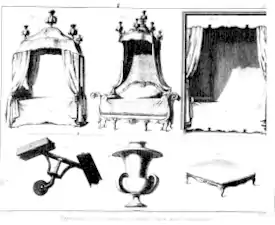Polish bed
A Polish bed (French: Lit à la polonaise; French: [pɔlɔnɛz]), alternatively known in English as a polonaise, is a type of canopy bed draped with a baldachin, which originated in 18th-century Poland.[1] The curtain is topped with an elaborate crownlike centrepiece that is connected to the four corner posts of the bed frame that are usually curved.[2] Historically, a Polish bed was placed on its side against the wall to serve as a daybed.[3] Nowadays, any type of curtained daybed or couch is known under this term.

The Polish bed shares many similarities with the lit à la turque, however Turkish-styled beds contain two scrolling ends and the curtains are of Oriental design.
Polonaise bedding was possibly first observed at the Royal Castle in Warsaw, at the time when Ottoman styles were considered fashionable across Europe. They were popularized in France by Polish-born queen Marie Leszczyńska, who was married to Louis XV of France.[4] Hence, it became a principal piece of the so-called Louis XV furniture.[4] These richly decorated rococo beds were generally designated for the wealthier upper classes and aristocracy that resided in palaces,[5] however, canopies were also commonplace in many standard homes due to their immense popularity. The French propagated the design as lit à la polonaise, which spread worldwide and together with an earlier four-poster bed developed into a contemporary canopy bed.
Polish beds dating back to the period can be found in museums, most famous being the Palace of Versailles in France. The polonaise should not be confused with the lit à la Duchesse where the canopy is only supported from one end.[6]
Gallery
 A Polish bed in one of the royal chambers at Versailles
A Polish bed in one of the royal chambers at Versailles Polonaise bed (top left), followed by a Turkish bed (middle), Paris, 1771
Polonaise bed (top left), followed by a Turkish bed (middle), Paris, 1771 Canopied bed of Empress Marie Louise, wife of Napoleon
Canopied bed of Empress Marie Louise, wife of Napoleon

References
| Wikimedia Commons has media related to Lit à la polonaise. |
- "Lit à la polonaise | Paris Musées". parismuseescollections.paris.fr.
- "The Wrightsman Collection. Vols. 1 and 2, Furniture, Gilt Bronze and Mounted Porcelain, Carpets". Metropolitan Museum of Art – via Google Books.
- Asid, Jeff Fiorito, Allied (July 13, 2015). "Fiorito Interior Design: Know Your Sofas Beds: The Lit à la Polonaise".
- Singleton, Esther (December 12, 2019). "French and English furniture distinctive styles and periods described and illustrated". Good Press – via Google Books.
- "Définition d'un lit à la polonaise - Petit dais arrondi sur montants métalliques". www.meubliz.com.
- "Définition d'un lit à la duchesse". www.meubliz.com.